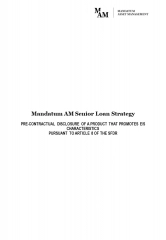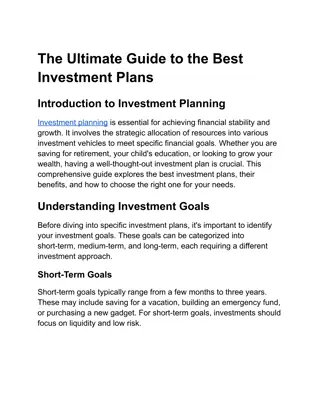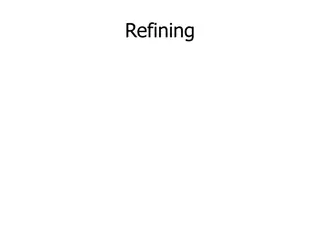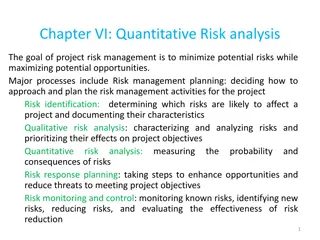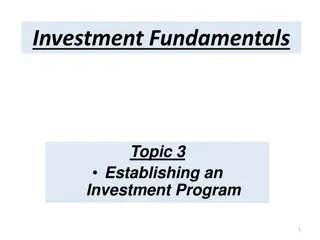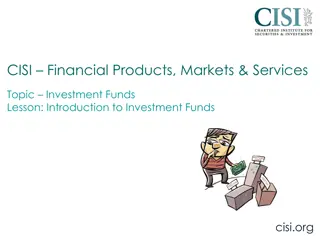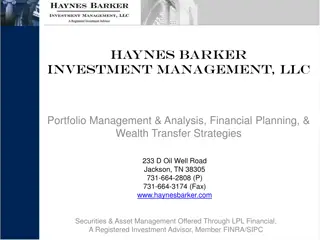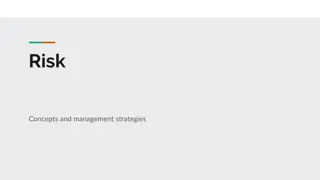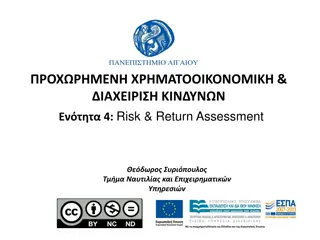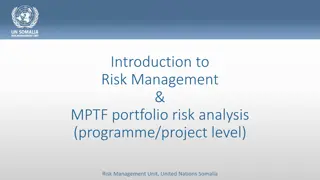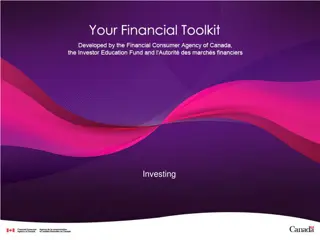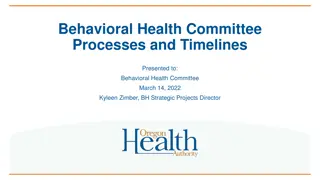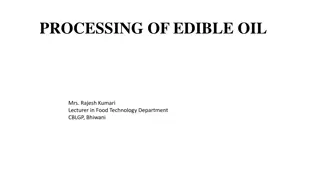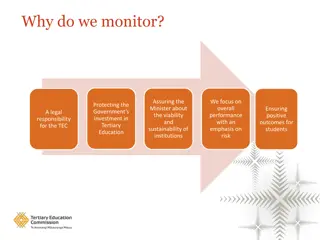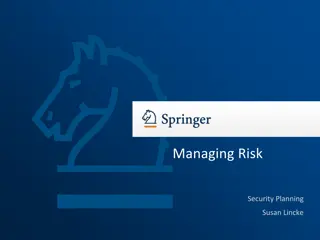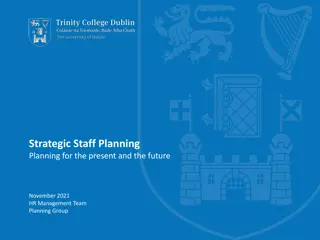Understanding and Refining Risk in Investment Planning
Investment planning involves understanding liquidity needs, as exemplified by the LTCM case study in 1998. Refining investment style entails assessing risk as uncertainty and aligning it with individual risk appetite and goal timelines. The analogy of driving helps explain different approaches to handling risk in investments.
Download Presentation

Please find below an Image/Link to download the presentation.
The content on the website is provided AS IS for your information and personal use only. It may not be sold, licensed, or shared on other websites without obtaining consent from the author. Download presentation by click this link. If you encounter any issues during the download, it is possible that the publisher has removed the file from their server.
E N D
Presentation Transcript
Minimalist Art of Investing Ep 4: Refining investment style Sandeep Tyagi
Recap: First Three Episodes Difficult to predict one year returns, easier to predict over long periods On an average Sensex gave 11.4% returns (CAGR) over 10-years rolling returns FD returns average is at 8.2% 60-40 model portfolio has 10.76% average returns Savings rate of 25 to 40% is healthy Investment Planning for 3 big goals: Retirement, Buying a home, children education Templates provided on Gulaq.com: Renting vs Buying Retirement Planning Childrens Education
OFFER FOR FREE CONSULTATION Follow us on social me dia Tag us Make a re que st F O LLO W U S O N Sandeep Tyagi GULAQ LinkedIn: https://www.linkedin.com/in/styagi/ LinkedIn: https://www.linkedin.com/in/gulaqnew Twitter: https://twitter.com/styagi Twitter: https://twitter.com/gulaqfintech Instagram: https://www.instagram.com/gulaqfintech/
Liquidity Needs The ability to convert investment into spendable cash is called Liquidity. Understanding when you need money is a crucial aspect in investment planning. This is called Liquidity need. If you own a farm in a remote part of the country, it might be tough to sell and convert into cash. In this case, liquidity is very low. Understanding the impact of cashing out investments when they are at a low value is equally important in assessing liquidity need.
Liquidity Needs LTCM (1998) case study Unravelling of a hedge fund - Long term capital management in 1998 is a startling example of understanding the liquidity need. LTCM was the shining star of financial world in most of 1990s Noble laureates Myron Scholes and Robert Merton were the principals of the firm The fund had golden run for several years In 1998, as Russia went through default, LTCM lost money There were no buyers for securities held by LTCM They continued to lose more and more money, and their securities couldn t cover their losses Finally, the fund got sold off to 14 banks The owners the smartest investors in the world lost billions of dollars in this sale
Refining investment style Most people view Risk as loss of principal. In investment world, risk is measured by uncertainty. Investments like FDs are reliable, but they give lower returns. Then there are other investments like Equities, with higher profits and higher uncertainty. Risk appetite depends primarily on 2 factors Your attitude towards uncertainty Safety margin Higher the savings, and longer the goal, higher the uncertainty you are comfortable with
Refining investment style Driving analogy Driving is very similar to investing. Some people drive fast, and others drive carefully. Driving behaviour can be explained using: Your personality Some people are comfortable driving fast, and don t feel stressed keeping fully alert Others are cautious, and not comfortable going high speeds This thrill for speed or being cautious got nothing to do with the car or road conditions Driving conditions Drivers got to adjust to weather and road conditions Even the speed loving ones For ex: When it rains heavily, we tend to drive slowly. In open roads, we drive faster
Refining investment style Driving analogy Driving is very similar to investments. We need to assess investment situation and accordingly decide the risk and returns needed. If we need money urgently or got just enough money, we can t afford to take risks. We invest the money in FDs. If the goals are distant, and we got good savings, then we can expect more growth by taking higher risk. Hence, we can invest in equities. Your risk tolerance is a combination of your personality and market conditions. At Gulaq, we follow Gear-based investing.
Gear based investing Gear 6 Gear 5 Gear 4 Gear 3 Gear 2 Gear 1 Equity 100% 80% 60% 40% 20% 0% Debt 0% 20% 40% 60% 80% 100% Average Returns 11.2% 11.1% 10.76% 10.16% 9.29% 8.2%
Gear based investing Which is your preferred investment gear? a) Gear 6 b) Gear 5 c) Gear 4 d) Gear 3 e) Gear 2 f) Gear 1
Major factors - Risk Tolerance Its not easy to know your risk tolerance. Hence, we have designed a Risk calculator on Gulaq.com. It s a combination of the following factors: Holding period of investment Spending behaviour of investment Income sources Experience with Equity products Investment objective Behaviour in falling markets Acceptable returns range
Risk Calculator Know your risk appetite Its not easy to know your risk tolerance. Hence, we designed a Risk calculator on Gulaq.com Go to Gulaq.com Risk calculator under Tools section Answer 7 basic questions about your investing behaviour Know Your Risk appetite Recommended Gear based investment portfolio Start investing
Case Study Chanchal Kumar has saved Rs. 9 Lakhs. He expects to buy a home and would require Rs. 10 Lakhs as downpayment in next 5 years. How should he assess the impact of his liquidity need on this savings plan?
Case study Can Chanchal invest in Gear 5? a) Yes, higher average returns makes it easier to reach goal Liquidity assessment template provided on Gulaq.com b) No, worst scenario is falling short of goal requirement
Gear based investing 5 Year Rolling Returns Gear 6 Gear 5 Gear 4 Gear 3 Gear 2 Gear 1 Average Returns 11.2% 11.1% 10.8% 10.2% 9.5% 8.5% Best Returns 24.8% 22.4% 19.4% 15.5% 11.9% 11.6% Worst Returns 0.0% 2.4% 4.5% 6.4% 7.1% 6.3% Gear 6 Gear 5 Gear 4 Gear 3 Gear 2 Gear 1 Average 15,31,641 15,24,768 15,02,939 14,65,340 14,14,229 13,51,421 Best outcome 27,24,680 24,72,576 21,84,058 18,49,918 15,79,039 15,60,081 Worst outcome 8,99,100 10,13,310 11,21,564 12,27,300 12,68,206 12,23,268 *Equity = BSE Sensex, Debt = FD Returns, 90% confidence
Gear based investing 5 Year Rolling Returns *Equity = BSE Sensex, Debt = FD Returns, 90% confidence
Case Study Chanchal has 9 Lakhs savings, and has a liquidity need of 10 Lakhs in 5 years Average and best cases of all gears can help Chanchal reach his goal If we look at worst cases Gear 6 investment would make him fall short of the goal Gear 1, 2, 3, 4, 5 investments will meet the liquidity need As Gear 5 has higher expected return, Chanchal should invest in Gear 5 portfolio
Gear based investing Right level of risk depends on two factors: Savings available Goal time period If you have larger savings compared to needs, sensible to take more risk Excess return helps in additional return without missing on goals
Tools used in this Episode Gulaq Risk Calculator Gulaq Liquidity Assessment Template
Coming Episode Asset Allocation
Thank You F O LLO W U S O N Sandeep Tyagi GULAQ LinkedIn: https://www.linkedin.com/in/styagi/ LinkedIn: https://www.linkedin.com/in/gulaqnew Twitter: https://twitter.com/styagi Twitter: https://twitter.com/gulaqfintech Instagram: https://www.instagram.com/gulaqfintech/


